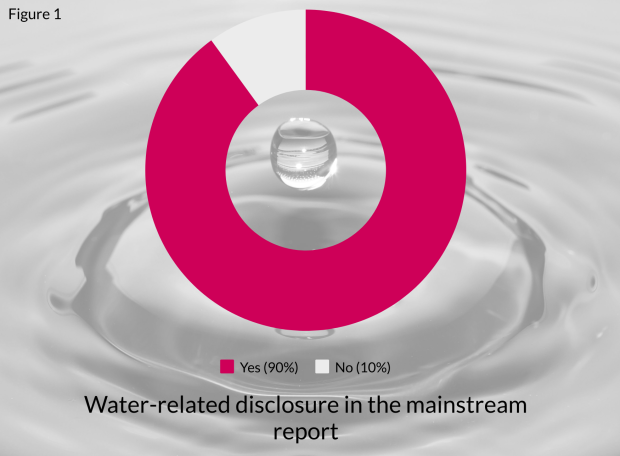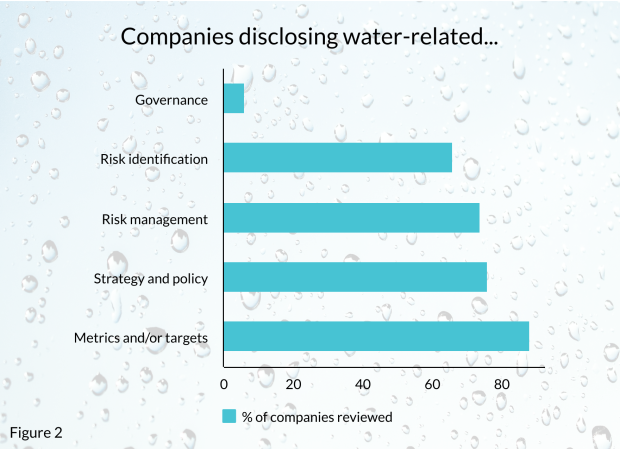With World Water Day just around the corner on Sunday 22 March 2020, CDSB’s Technical Manager, Francesca Recanati, shares a snapshot of current practices in water-related reporting by companies.

Heightened attention has been paid to climate-related financial disclosures over the past few years, and we have recently seen a growing interest in nature-related financial disclosures. For example, in the UK, the 2019 Green Finance Strategy said the UK would “work with international partners to catalyse market-led action on enhancing nature-related financial disclosures”. The EU has also stated in its Green Deal that “the Commission will also support businesses and other stakeholders in developing standardised natural capital accounting practices within the EU and internationally.”
But what is the current state of practice today?
Supported by the EU LIFE Programme, CDSB is currently undertaking the most up-to-date extensive analysis of climate and environmental disclosure practices by major European companies. The findings will inform policymakers of the regulatory reforms needed to improve reporting in line with the Non-Financial Reporting Directive to offer guidance to companies on how to enhance their disclosure and meet the objectives of the EU Green Deal.
While the full findings of the review are set to be released in May, we wanted to provide a preview of how companies are disclosing water-related information to investors and other key stakeholders.
The majority of companies rely on water as a primary resource; their operations and value chains impact and depend on both the amount and quality of water resources. Climate change is affecting and will continue to affect water resources in the future. For this reason, water-related information can, in many cases, be considered a financially material issue worth disclosing in the corporate mainstream report to support investors’ decisions.
Of the company reports CDSB reviewed, nine in ten companies disclose water-related information in their 2018 mainstream report.

Figure 1: Percentage of companies CDSB reviewed that disclose water-related information in the mainstream report.
We found that:
- Only a handful (6%) disclose details on water-specific governance;
- Three-quarters describe their strategy and policies towards the management of water resources and two-thirds identify water-related risks; and
- Three-quarters disclose interventions contributing to their water-related goals and targets and some, but not all, relate these back to risks identified of corporate disclosures of water-related information.

Figure 2: Percentage of companies CDSB reviewed that disclose water-related governance, risk identification, risk management, strategy and policy, metrics and/or targets information.
From our analysis, we identified three main areas for improvement of corporate disclosures of water-related information:
- Assessment of water-related risks and, most of all, of their links to climate-related risks is often not clear and accurate: some companies experiencing water-related impacts (e.g. water scarcity) do not consider water in their risk assessment;
- Water-related information on risks, strategy and policy are often not clearly linked with targets and metrics; and this can reduce the effective support to decision-makers, both internal and external to the company; and
- Different terminology indicating the water use, e.g. consumption, requirement, abstraction, and withdrawals, are used in the same document and often without a clear explanation of the meaning and of what the assessment is considering (i.e. which water flows are included and which are not).
Nevertheless, some good practices are present in our snapshot of water-related disclosures, especially in disclosures from the food and beverage, and chemical sectors. These companies either: (i) rely on agricultural raw materials that strongly rely on water resources; or (ii) have multi-annual experience in water and wastewater management. Besides clearly and accurately identifying water-related risks (also linked to climate change), these companies present clear governance and strategies to manage these risks through continuous monitoring, assessment with science-based methodologies, prioritisation of intervention in water-stressed areas, and clear communications to investors and other key stakeholders.
Overall, the reviewed mainstream reports show heterogeneity in the disclosed water-related information, low conciseness and sparse structure of water-related information, use different metrics and accounting methodologies, and often miss to describe methodological details. Further improvements are therefore needed to deliver decision-useful water-related information for investors, but existing good practices constitute a promising starting point.
What do you think of these findings? Are you working on water-related disclosures? CDSB would like to speak with you and learn more. Contact .
Be the first to receive updates on CDSB’s work and the launch of the complete review of climate and environmental disclosure in May by signing up to the CDSB newsletter here.
This publication is funded in part by the Gordon and Betty Moore Foundation.
